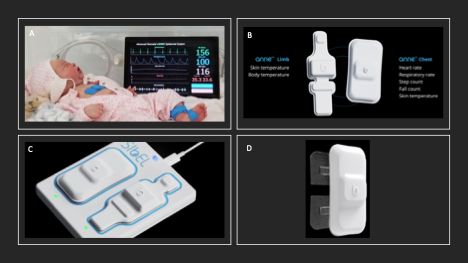Neonatal General
Neonatal General 11
77 - The Use of Wireless Sensors for Heart Rate Monitoring in the Neonatal Intensive Care Unit: A Feasibility Study
Publication Number: 77.43

Eva B. Senechal, BA & Sc. (she/her/hers)
MSc. Candidate
aculty of Medicine and Health Sciences, Division of Experimental Medicine, McGill University
Montréal, Quebec, Canada
Presenting Author(s)
Background:
Heart rate (HR) monitoring by using sensors connected to monitors via wires and cables is the standard of care in neonatal intensive care units (NICU). This system may be associated with tangling and damage of the wires, cables, and skin. Additionally, it requires constant nursing care and hinders the parents’ ability to hold and bond with their child during Kangaroo Care. Recently, a wireless neonatal monitoring system was developed (ANNE® One; Sibel Health - Figure 1).
Objective:
To determine the accuracy of a new wireless system for heart rate monitoring in the NICU.
Design/Methods:
NICU patients were enrolled after parental consent. Sensors were applied, and signals monitored for 8h/day, on four consecutive days, using ANNE® One and the standard Intellivue MX 450 monitors. Both systems were connected to a research BioDash for simultaneous data acquisition and signals were aligned by using a pre-processing algorithm. HR was analyzed by two biomedical engineers blinded to the experiments for: a) coverage – % of recordings with available signal, b) gaps - periods of ≥1.25 ms where one or more sequential samples were missing, and c) amplitude structure – probability histogram of HR (bin width of 1 bpm) characterized by the mean, standard deviation, skewness, and kurtosis. For the relation between the two HR signals the Bland-Altman analysis was applied. The proportional relation between the signals was evaluated by computing the correlation coefficient, the slope, and its predictive ability (% of the observed variance or vaf%).
Results:
A total of 10 patients were studied resulting in 40 different recordings and 320 hours of data. The median gestational age was 29 weeks (IQR: 27–33), and corrected age at enrollment was 37 weeks (IQR: 34–40). There was strong agreement between wireless and wired HR signals, with an average correlation of 0.95±0.04, slope of 1.00, and variance accounted for of 89.6±7.6. Bland-Altmann analysis showed a low bias (Figure 2). There was a significantly greater % coverage in the wired compared to the wireless recordings (98.8±1.6 vs 86.1±13.8). Additionally, these gaps were more frequent (66±67 vs 3.4±5.0%) and longer (3.6±3.9 vs 2.8±4.3 sec/recording) with the wireless system (Figure 3).
Conclusion(s):
Monitoring of HR in the NICU by using a new wireless system showed strong agreement with the standard wired monitoring. Frequent and longer gaps without signals observed with the wireless system is under analysis to determine the role of lead connectivity, Bluetooth transmission, and signal strength. 
.png)
.png)
